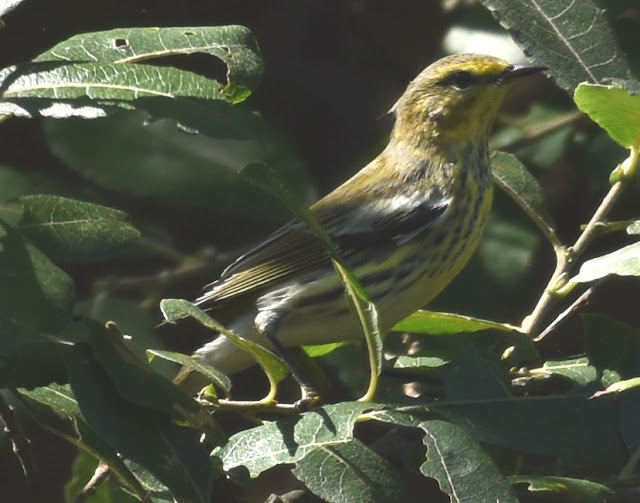Of the
thirty or so species of goldenrod (Solidago)
on our continent, at least nine can be found at Halibut Point. They're bright,
beautiful, and hard to tell apart. Newcomb's
Wildflower Guide has been a helpful source for the clues presented below.
 |
|
(1) Tall goldenrod, S. altissima |
Since the
individual flowers are tiny and very
similar in appearance, leaves and stems often provide easier keys to
identification. Tall goldenrod falls with a group whose leaves are more or less
uniform in size and shape the whole length of the stem, or are gradually
reduced in size from base to top.
 |
|
Tall goldenrod, S. altissima (detail of photo) |
In the case
of Tall goldenrod (1), the photo shows that its leaves are three-veined, with
two prominent veins running parallel to the midrib. The leaves are remotely
toothed, rough above, downy underneath.
 |
|
(2) Sweet goldenrod, S. odora |
Sweet
goldenrod (2) is similar but its leaves are not noticeably veined, and their
edges are smooth. The leaves are usually anise-scented when bruised.
 |
|
(3) Elliott's goldenrod, leaf detail |
The leaves
of Elliott's goldenrod are broader, rougher, and distinctively toothed leaf
edges.
 |
Elliott's goldenrod, S. elliottii
|
 |
|
(4) Rough-stemmed goldenrod, S. rugosa |
Those
descriptors fit the Rough-stemmed goldenrod as well. However, the bristly
nature of the stems sets this species apart.
 |
Rough-stemmed goldenrod, detail
|
 |
|
(5) Showy goldenrod, S. speciosa |
Showy
goldenrod is yet another species with uniformly-sized leaves.
 |
|
Showy goldenrod, S.
speciosa |
It's flower
cluster is unmistakably large and
branching. As the the last species to bloom on Halibut Point, it is
particularly satisfying to the eye and to hungry insects.
 |
|
(6) Grass-leaved goldenrod, S. graminifolia |
Grass-leaved
goldenrod also branches at the top, forming flattish flower clusters. Its
namesake leaves are very narrow.
 |
|
(7) Early goldenrod, S. Juncea |
A separate
classification of goldenrods produces flowers in curved, one-sided clusters.
Species in this group have basal and lower leaves considerably larger than the upper
ones. On Early goldenrod they are sharply toothed, lance-shaped, and tapering
gradually to the base.
 |
|
(8) Gray goldenrod, S. nemoralis |
On
similar-looking Gray goldenrod the basal leaves are bluntly or obscurely
toothed. The stems and leaves are grayish and fine-hairy.
 |
|
(9) Seaside goldenrod, S. sempervirens |
Seaside
goldenrod, also with curved, one-sided flower clusters, produces smooth
succulent leaves that help it to survive desiccation in windy, salty locations
with undependable fresh water.
 |
|
Seaside goldenrod, S. sempervirens |
By
appearance and niche the Seaside goldenrod is the easiest to identify and one
of the hardiest plants on the shoreline.
























































